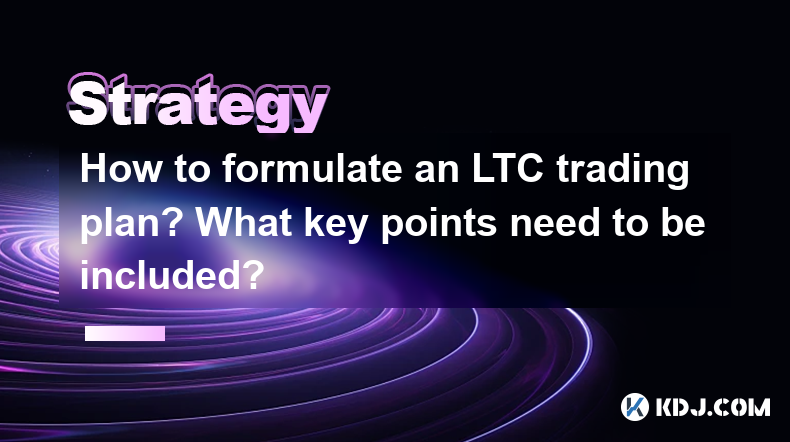-
 bitcoin
bitcoin $115692.075601 USD
5.13% -
 ethereum
ethereum $4162.931611 USD
11.68% -
 bnb
bnb $1310.063287 USD
17.56% -
 tether
tether $1.000983 USD
0.00% -
 xrp
xrp $2.534505 USD
8.16% -
 solana
solana $198.235737 USD
13.49% -
 usd-coin
usd-coin $1.000236 USD
0.02% -
 dogecoin
dogecoin $0.207352 USD
12.89% -
 tron
tron $0.323043 USD
3.62% -
 cardano
cardano $0.701559 USD
11.88% -
 hyperliquid
hyperliquid $39.924597 USD
8.30% -
 chainlink
chainlink $18.934457 USD
11.56% -
 ethena-usde
ethena-usde $1.000552 USD
0.02% -
 stellar
stellar $0.340575 USD
7.05% -
 bitcoin-cash
bitcoin-cash $545.011757 USD
8.86%
How to formulate an LTC trading plan? What key points need to be included?
A solid Litecoin trading plan is crucial for navigating crypto markets, involving clear goals, market analysis, strategy development, risk management, and regular adjustments.
May 02, 2025 at 02:42 am

Creating a solid Litecoin (LTC) trading plan is essential for any trader looking to navigate the volatile cryptocurrency markets effectively. A well-formulated trading plan not only helps in managing risks but also in maintaining discipline and consistency in trading activities. In this article, we will explore how to formulate an LTC trading plan and highlight the key points that need to be included.
Understanding the Basics of Litecoin
Before diving into the specifics of formulating a trading plan, it's crucial to have a basic understanding of Litecoin. Litecoin is a peer-to-peer cryptocurrency created in 2011 by Charlie Lee, a former Google engineer. It is often considered the silver to Bitcoin's gold, offering faster transaction times and a different hashing algorithm (Scrypt). Understanding these fundamentals helps in making informed trading decisions.
Setting Clear Trading Goals
The first step in formulating an LTC trading plan is to set clear and achievable trading goals. These goals should be specific, measurable, attainable, relevant, and time-bound (SMART). For instance, a goal might be to achieve a 10% return on investment within three months. Setting clear goals helps in maintaining focus and measuring progress.
Conducting Market Analysis
A comprehensive market analysis is a cornerstone of any trading plan. This involves both technical and fundamental analysis. Technical analysis involves studying price charts and using indicators like moving averages, RSI, and MACD to predict future price movements. Fundamental analysis, on the other hand, involves evaluating the intrinsic value of Litecoin based on factors like adoption rates, technological developments, and market sentiment. Both types of analysis are crucial for making informed trading decisions.
Developing a Trading Strategy
Once the market analysis is complete, the next step is to develop a trading strategy. This strategy should outline the entry and exit points, risk management techniques, and the types of trades to be executed (e.g., day trading, swing trading, or long-term holding). For example, a strategy might involve buying LTC when it breaks above a certain resistance level and selling when it reaches a predetermined profit target. A well-defined trading strategy is essential for consistent trading performance.
Risk Management
Risk management is a critical component of any trading plan. It involves setting stop-loss orders to limit potential losses, determining the appropriate position size based on the account balance, and diversifying the trading portfolio to spread risk. For instance, a trader might decide to risk no more than 2% of their trading capital on any single trade. Effective risk management helps in protecting the trading capital and ensuring long-term sustainability.
Monitoring and Adjusting the Plan
A trading plan is not a static document; it requires regular monitoring and adjustments based on market conditions and trading performance. This involves reviewing the trading journal to identify what is working and what is not, and making necessary adjustments to the trading strategy and risk management rules. Regular monitoring and adjustments ensure that the trading plan remains relevant and effective.
Keeping a Trading Journal
Maintaining a trading journal is an invaluable part of any trading plan. It helps in tracking trades, analyzing performance, and learning from both successes and failures. The journal should include details such as the date of the trade, entry and exit points, the rationale behind the trade, and the outcome. Keeping a detailed trading journal aids in continuous improvement and refinement of the trading strategy.
Staying Informed
The cryptocurrency market is highly dynamic, with new developments and news impacting prices frequently. Staying informed about the latest news, market trends, and technological advancements related to Litecoin is crucial. This can be achieved by following reputable cryptocurrency news sources, joining trading communities, and participating in forums. Staying informed helps in making timely and informed trading decisions.
Emotional Discipline
Trading can be an emotionally charged activity, especially in the volatile cryptocurrency markets. Maintaining emotional discipline is essential for sticking to the trading plan and avoiding impulsive decisions. This involves setting rules for when to take breaks, how to handle winning and losing streaks, and maintaining a balanced perspective. Emotional discipline is key to long-term trading success.
Backtesting and Paper Trading
Before implementing the trading plan with real money, it's advisable to backtest the strategy using historical data and engage in paper trading. Backtesting involves running the trading strategy against past market data to see how it would have performed. Paper trading involves simulating trades in real-time without using real money. Both practices help in refining the trading strategy and building confidence before going live.
FAQs
Q: How often should I review and adjust my LTC trading plan?A: It's recommended to review your trading plan at least once a month or whenever there are significant changes in market conditions or your trading performance. Regular reviews help in keeping the plan relevant and effective.
Q: Can I use the same trading plan for other cryptocurrencies?A: While the core principles of a trading plan can be applied to other cryptocurrencies, it's important to tailor the plan to the specific characteristics and market dynamics of each cryptocurrency. For instance, the volatility and trading volume of LTC might differ from other cryptocurrencies, requiring adjustments to the trading strategy and risk management rules.
Q: What should I do if my trading plan is not working as expected?A: If your trading plan is not working as expected, start by reviewing your trading journal to identify any patterns or issues. Consider whether the market conditions have changed, if your risk management rules are too lenient or strict, or if your trading strategy needs refinement. It's also helpful to seek feedback from experienced traders or mentors.
Q: How important is it to stick to my trading plan?A: Sticking to your trading plan is crucial for maintaining discipline and consistency in your trading activities. Deviating from the plan can lead to emotional trading and increased risk. However, it's also important to be flexible and make adjustments when necessary based on market conditions and performance reviews.
Disclaimer:info@kdj.com
The information provided is not trading advice. kdj.com does not assume any responsibility for any investments made based on the information provided in this article. Cryptocurrencies are highly volatile and it is highly recommended that you invest with caution after thorough research!
If you believe that the content used on this website infringes your copyright, please contact us immediately (info@kdj.com) and we will delete it promptly.
- XRP Price Prediction: Weekend Rollercoaster or Rally?
- 2025-10-12 08:45:16
- Bittensor (TAO): Super Bullish Signals Point to Potential 2x Rally
- 2025-10-11 10:25:12
- Silver Price Correction: Navigating the Dip & Identifying Key SEO Keywords
- 2025-10-11 10:25:12
- Decoding Crypto Trends: Bittensor's Bull Run, Cardano's Dip, and LivLive's Presale Buzz in 'Uptober 2025'
- 2025-10-12 08:45:16
- MoonBull: The Crypto Meme Coin Promising 1000x Gains?
- 2025-10-11 10:30:01
- Crypto Payroll Revolution: Stablecoins, Altcoins, and the Future of Salary Payments
- 2025-10-11 10:30:01
Related knowledge

Practical parameter settings for a Bitcoin multi-timeframe moving average system
Sep 18,2025 at 10:54pm
Optimizing Timeframe Combinations for Bitcoin Trading1. Selecting appropriate timeframes is crucial when building a multi-timeframe moving average sys...

How can I filter out false breakouts in Dogecoin high-frequency trading?
Sep 22,2025 at 01:00am
Understanding False Breakouts in Dogecoin Trading1. A false breakout occurs when Dogecoin's price appears to move beyond a defined support or resistan...

Techniques for identifying tops and bottoms in the Bitcoin on-chain NVT model
Sep 20,2025 at 07:54pm
Understanding the NVT Model in Bitcoin Analysis1. The Network Value to Transactions (NVT) ratio is often described as the 'P/E ratio' of the cryptocur...

What does the surge in open interest in Bitcoincoin futures mean?
Sep 20,2025 at 11:18pm
Understanding the Surge in Dogecoin Futures Open Interest1. A surge in open interest within Dogecoin futures indicates a growing number of active cont...

How can I use the Ethereum USDT premium to gauge market sentiment?
Sep 18,2025 at 11:55pm
Understanding the Ethereum USDT Premium1. The Ethereum USDT premium refers to the price difference between USDT (Tether) traded on Ethereum-based plat...

What should I do if Ethereum staking yields decline?
Sep 20,2025 at 06:18am
Understanding the Causes Behind Declining Ethereum Staking Yields1. The Ethereum network transitioned to a proof-of-stake consensus mechanism with the...

Practical parameter settings for a Bitcoin multi-timeframe moving average system
Sep 18,2025 at 10:54pm
Optimizing Timeframe Combinations for Bitcoin Trading1. Selecting appropriate timeframes is crucial when building a multi-timeframe moving average sys...

How can I filter out false breakouts in Dogecoin high-frequency trading?
Sep 22,2025 at 01:00am
Understanding False Breakouts in Dogecoin Trading1. A false breakout occurs when Dogecoin's price appears to move beyond a defined support or resistan...

Techniques for identifying tops and bottoms in the Bitcoin on-chain NVT model
Sep 20,2025 at 07:54pm
Understanding the NVT Model in Bitcoin Analysis1. The Network Value to Transactions (NVT) ratio is often described as the 'P/E ratio' of the cryptocur...

What does the surge in open interest in Bitcoincoin futures mean?
Sep 20,2025 at 11:18pm
Understanding the Surge in Dogecoin Futures Open Interest1. A surge in open interest within Dogecoin futures indicates a growing number of active cont...

How can I use the Ethereum USDT premium to gauge market sentiment?
Sep 18,2025 at 11:55pm
Understanding the Ethereum USDT Premium1. The Ethereum USDT premium refers to the price difference between USDT (Tether) traded on Ethereum-based plat...

What should I do if Ethereum staking yields decline?
Sep 20,2025 at 06:18am
Understanding the Causes Behind Declining Ethereum Staking Yields1. The Ethereum network transitioned to a proof-of-stake consensus mechanism with the...
See all articles























![[4K 60fps] Anyway by Retropt (1 Coin) [4K 60fps] Anyway by Retropt (1 Coin)](/uploads/2025/10/13/cryptocurrencies-news/videos/k-fps-retropt-coin/68ec4f42a41d0_image_500_375.webp)


















































